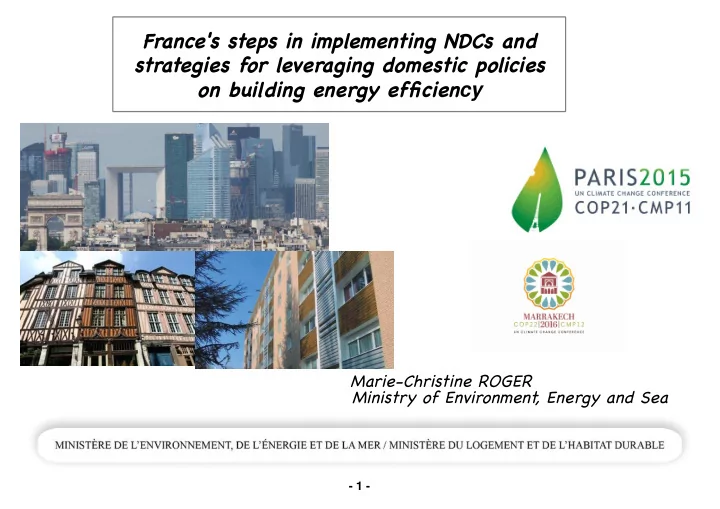

France's steps in implementing NDCs and strategies for leveraging domestic policies Title on building energy efficien cy Marie-Christine ROGER Ministry of Environment, Energy and Sea - 1 -
National determined contributions for Europe 40% domestic reduction in GHG emissions by 2030 compared to 1990 20% emission reduction commitment by 2020 compared to 1990 - 2 -
E uropean policy French National determined contributions for European Policy Countries=>Targets 2030 Energy Efficiency directive(EED ) Energy Performance of buildings Renewables directive(EPBD) directive Energy transition Law (LTECV-2015) Housing energy renovation Plan (PREH-2014) French Policies are rooted in the EU framework - 3 -
Breakdown of GHG emissions and energy consumptions per sector Le bâtiment en chiffres Some Greenhouse gas emissions in France(GES) Source : ADEME, 2009 Energy consumptions in buildings in France Source : Chiffres-clés climat, air et énergie, Ademe, édi9on 2015 - 4 -
A French administrative organisation renewed in 2007 § In 2007, after his election, the President of France decided to gather in the same Ministry policies relevant to environment, energy, housing policies and climate negociations issues: the ministry of Ecology, Energy, Sustainable Development and Sea, in charge of climate negociations was born. § Besides, he launched the « Grenelle de l’environnement round table », which was a conference bringing together the government, local authorities, trade unions, business and voluntary sectors to draw up an action plan to tackle the environmental issue Both Grenelle de l’environnement and the redimensioned Ministry were a turning point in environmental policies - 5 -
French administrative org anisation • France is a unitary state, not a federated one • Laws and decrees are edicted by the Government at the national level, • Building codes define the framework of regulations targeting efficiency of buildings • All over the country developers comply with the same regulation (depending on local climate) =>This organisation facilitates NDCs implementation up to a point Regulation is not the only leverage to foster energy efficiency: involving local authorities is highly recommended! - 6 -
Context of the Act relating to Energy Transition for Green Growth Last 17th of August 2015, a new and fundamental law was issued by the French Government The Act on Energy Transition for Green Growth is consistent with a process that has been implemented for several years with regard to improving both new and existing building stock The Act sets out: § Medium and long-term goals… § … and operational measures… … which consolidated the 2014 French strategy to foster renovation, T he « Housing energy renovation the « Housing Energy Renovation Plan » Plan » (PREH) - 7 -
The key points of the French renovation strategy § Ambitious quantitative targets set out by the Energy transition law: § Achieving an annual rate of 500,000 dwellings renovated per year by 2017, including: § 120,000 in the social housing stock § 380,000 in the private housing stock § ….A strategy based on three pillars Specific support to households providing appropriate advice, § Involvement of the professional sector in costs-controlling and quality of works involving local authorities Improvement of financing scheme, especially towards disadvantaged households Involvement of the stakeholders ( craftsmen, building companies) in costs-controlling and quality of works - 8 -
Supporting households The public service for housing energy performance is based on a network of "regional energy renovation platforms » Between 100 000 and 500 000 monthly visits of the website Réflexénergie About 3000 phone calls SEM Energies Posit’if SPEE received at the national level Picardie Pass’Réno Habitat Habitat Solidaire every month 93 et Durable SAVéCOM Much information provided in Oktave Vir’Volt the PRIS-organisations ComCom de la Vallée de Tinergie Kaysersberg ComAg du Pays Voironnais Pays des 6 Mur|mur Vallées Plateforme de la Biovallée Plateforme REHAB - 9 -
The financing of energy renovation works The "Habiter Mieux" (Living Better) Program, implemented by ANAH, to combat fuel poverty, has been improved 70,000 renovations of dwellings owned by low-income households in 2016, 100,000 renovations expected in 2017 The relevant renovations account for an average energy saving of 40% For public social housing, a specific 0% loan scheme was implemented Tax credits are available to households willing to renovate • The relevant renovations account for an average energy saving of 39% their own property - 10 -
«From NZEBuildings to positive energy buildings » • Same objectives shared by the Energy Performance of Buildings Directive and the French regulation of new buildings « RT 2012 », enforced in 2012 • This high performance paves the way to the next generation of new buildings, positive energy and low carbon buildings • An experiment was launched to encourage front-runners to go further… - 11 -
Renovation strategies( art 4 of EED): 74% of the strategies address EED main elements 6 2 1 3 1 0 Overview of the national building stock Cost-effective approaches relevant to the building type and climatic zone; Measures to stimulate cost- effective deep renovations Perspective to guide investment decisions expected energy savings Evidence-based estimate of - 12 -
Thank you for your attention - 13 -
Recommend
More recommend